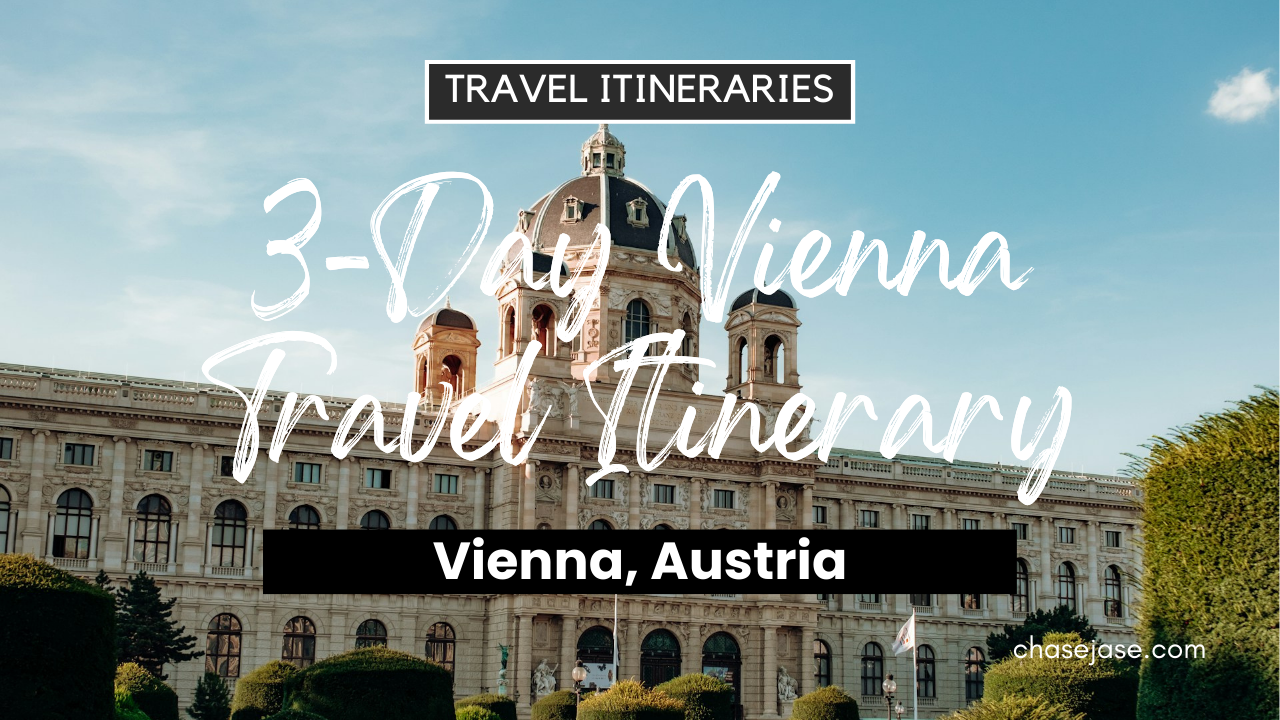3-Day Vienna, Austria Travel Itinerary

Introduction:
Vienna, the capital of Austria, is a city known for its imperial heritage, classical music legacy, baroque architecture, and vibrant café culture. It is home to former palaces of the Habsburg monarchy, world-renowned opera houses, and historic coffee houses. A 3-day trip to Vienna offers travelers a well-balanced mix of history, culture, and leisure. From the grandeur of Schönbrunn Palace to the sounds of Mozart and Strauss echoing through the Vienna State Opera, this itinerary allows you to explore Vienna’s rich past and elegant present in a structured and efficient manner.
Places to Visit:
- Schönbrunn Palace: This is a UNESCO World Heritage site and former imperial summer residence with 1,441 rooms and sprawling gardens.
- Hofburg Palace: This is the historic winter palace of the Habsburgs, now housing the Imperial Apartments, Sisi Museum, and Austrian National Library.
- St. Stephen’s Cathedral (Stephansdom): This Gothic masterpiece is the spiritual heart of Vienna and offers a panoramic view from its south tower.
- Belvedere Palace: This is a baroque palace complex that houses Austria’s most valuable art collections, including Gustav Klimt’s The Kiss.
- Vienna State Opera: This is one of the world’s most celebrated opera houses, offering guided tours and world-class performances.
- MuseumQuartier: This is one of the largest cultural complexes in the world, hosting the Leopold Museum, MUMOK, and contemporary art spaces.
- Kunsthistorisches Museum (Museum of Art History): This is a magnificent museum housing works by Caravaggio, Rembrandt, Vermeer, and more.
- Prater and Giant Ferris Wheel: This is a historic amusement park known for its 64.75-meter-tall Ferris wheel, providing views of the city.
- Naschmarkt: This is Vienna’s most popular open-air market, offering fresh produce, international cuisine, and antiques.
- Karlskirche (St. Charles Church): This is a baroque church with impressive frescoes and a panoramic elevator to its dome.

Sample Itinerary:
Day 1: Royal Heritage and Old Town Exploration
- 9:00 AM: Start at Schönbrunn Palace, touring the Imperial Apartments and walking through the Schönbrunn Gardens and Gloriette (2.5 hours).
- 12:00 PM: Take the U4 subway (15 minutes) to the city center for lunch at Plachutta Wollzeile, famous for Tafelspitz (1.5 hours).
- 2:00 PM: Visit Hofburg Palace, exploring the Sisi Museum and Imperial Apartments (2 hours).
- 4:00 PM: Walk to St. Stephen’s Cathedral, climbing its 343 steps for views over Vienna (1 hour).
- 6:00 PM: Stroll through the historic Graben and Kohlmarkt shopping streets (1 hour).
- 7:30 PM: Enjoy dinner at Figlmüller, known for the best Wiener Schnitzel (1.5 hours).
Day 2: Museums, Art, and Classical Music
- 9:00 AM: Visit Kunsthistorisches Museum to view world-famous art in a palatial setting (2 hours).
- 11:30 AM: Explore the MuseumQuartier, focusing on the Leopold Museum for its Austrian modern art collection (1.5 hours).
- 1:30 PM: Have lunch at Glacis Beisl, a hidden courtyard gem in the MuseumQuartier (1.5 hours).
- 3:00 PM: Tour the Belvedere Palace, especially Upper Belvedere, to see Klimt’s The Kiss (2 hours).
- 5:30 PM: Return to the city center (15 minutes via tram D) and prepare for an opera night.
- 6:30 PM: Early dinner at Steirereck im Stadtpark, a fine-dining restaurant (1.5 hours).
- 8:00 PM: Attend a performance at the Vienna State Opera (2.5 hours).

Day 3: Leisure, Markets, and Local Culture
- 9:00 AM: Start with breakfast at Café Central, a historic café frequented by Freud and Trotsky (1 hour).
- 10:00 AM: Visit Karlskirche, taking the elevator to see the dome frescoes up close (1 hour).
- 11:30 AM: Explore the vibrant Naschmarkt, sampling foods and browsing antiques (1.5 hours).
- 1:30 PM: Lunch at Neni am Naschmarkt, known for Middle Eastern fusion cuisine (1 hour).
- 3:00 PM: Take the U2 subway to Prater Amusement Park, riding the Giant Ferris Wheel (1 hour).
- 5:00 PM: Relax with a walk along the Danube Canal, enjoying street art and riverside cafés (1 hour).
- 7:00 PM: Farewell dinner at Gasthaus Pöschl, offering traditional Austrian dishes in a relaxed setting (1.5 hours).
See Itinerary Map (Includes Places to Visit and Accommodations)
Best Time To Go:
The best time to visit Vienna is during April to May and September to October. These shoulder seasons offer mild weather, fewer tourists, and blooming parks or autumn colors. Summer (June to August) is also a popular time due to open-air events and long daylight hours, but it is more crowded and expensive. Winter (late November to December) is magical for Christmas markets, especially in front of the City Hall, but colder temperatures require proper clothing.
Activities To Do:
- Attend a Classical Music Concert: Vienna is the city of Mozart, Beethoven, and Strauss. Concerts are held in venues like the Musikverein and Schönbrunn Orangery.
- Take a Fiaker Ride: A horse-drawn carriage tour around the old city is a nostalgic way to see landmarks.
- Explore Vienna’s Coffee House Culture: Visit iconic cafés like Café Sacher or Café Demel for coffee and Sachertorte.
- Cycle along the Danube: Rent a bike and follow scenic cycling routes along the Danube Canal or the Island.
- Visit a Heuriger (Wine Tavern): In the outskirts like Grinzing, traditional wine taverns offer local wine and live folk music.

Accommodations:
- Hotel Sacher: A legendary 5-star hotel next to the State Opera, known for luxury and its original Sachertorte.

- The Ritz-Carlton Vienna: Offers elegant rooms, rooftop views, and a prime location on the Ringstraße.

- Das Tigra Hotel: A boutique hotel close to the old city, with stylish interiors and great breakfast.

- 25hours Hotel at MuseumsQuartier: Offers quirky design, rooftop bar, and proximity to museums.

- Hotel Beethoven Wien: Located behind Theater an der Wien, it features themed rooms and a refined Viennese atmosphere.

- Motel One Wien-Staatsoper: A budget-friendly hotel just steps from the opera house, with sleek modern decor.

- MEININGER Hotel Wien Downtown Franz: A hostel-hotel hybrid offering shared and private rooms at great value.

Transportation Options:
- U-Bahn (Subway): Vienna’s five-line underground network is fast, clean, and ideal for reaching major sites.
- Trams: Over 30 tram lines connect inner districts and are perfect for scenic city travel.
- Buses: Supplement trams and subway routes, especially at night.
- S-Bahn (Suburban Rail): Connects Vienna to the airport and outer suburbs.
- Taxis and Rideshares: Available city-wide, though public transport is often faster and more affordable.
- Walking: The city center is pedestrian-friendly and walkable.
- Citybikes and Scooters: Rentals are available for quick and flexible transport.
- Vienna City Card: Offers unlimited travel on public transportation and discounts on attractions.
Tips:
- Buy a Vienna Pass or City Card: These offer free or discounted entry to many attractions and unlimited transport.
- Book Concerts and Museum Tickets Early: High demand can lead to sold-out events, especially in peak season.
- Carry Cash: Some cafés and markets prefer cash over cards.
- Mind the Dress Code: Opera houses and fine restaurants may require semi-formal attire.
- Learn Basic German Phrases: Although English is widely spoken, polite greetings in German go a long way.
Vienna is a city that gracefully blends the elegance of its imperial past with the vibrancy of modern European culture. A 3-day itinerary provides ample time to admire baroque palaces, immerse in classical music, explore artistic treasures, and enjoy the city’s legendary cafés. With efficient public transport, diverse accommodations, and well-preserved landmarks, Vienna, Austria is a top-tier destination for culture seekers and casual travelers alike. Whether walking through royal gardens or applauding a Mozart concert, Vienna guarantees unforgettable experiences wrapped in charm and sophistication.



